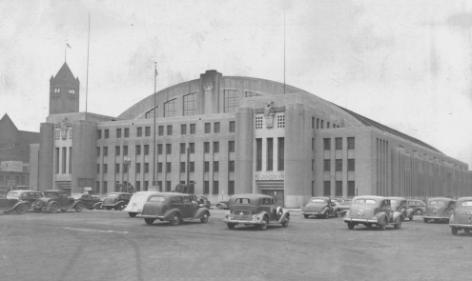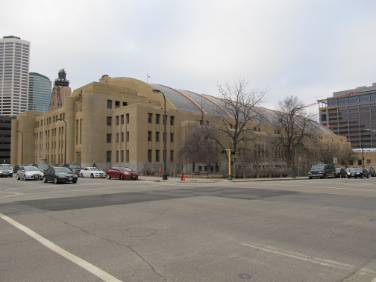Overview
The Minneapolis Armory is an outstanding example of the PWA Moderne style.
- Location: 500 6th Street South
- Neighborhood: Elliot Park
The Minneapolis Armory is an outstanding example of the PWA Moderne style.


The Minneapolis Armory is an outstanding example of the PWA Moderne style. It also reflects the work of New Deal projects to boost the economy in the 1930s. This large brick building was built in 1935-36. It has a rounded roof and recessed windows. The entrances have tall, rounded corners and carved stone accents. This building housed 27 units of the Minnesota National Guard and Naval Militia.
The PWA Moderne architectural style evolved from previous styles. It focused on efficiency, economy, and formal proportions. It was often used for federal government buildings. PWA refers to the Public Works Administration. It was created in 1933 to increase construction jobs during the Great Depression. The PWA also helped fund public construction projects, including the Minneapolis Armory.
P.C. Bettenburg was an architect and engineer who served in World War II. He designed more than 20 armories in Minnesota, including this one. He also worked on a master plan for Camp Ripley Military Reservation.
Master engineer Walter H. Wheeler also worked on this building. He invented the Wheeler Shear Head, which was a special type of flat-slab ceiling design. It simplified construction, eliminated wasted space, and reduced the cost of fireproof buildings. The Minneapolis Armory’s drill house is an early local application of this invention.
The Minneapolis Armory has two Federal Art Project murals in the trophy room from 1937. Both are examples of fresco painting. Lucia Wiley’s mural shows the history of the National Guard. Elsa Jemne’s mural depicts a rural scene of early Minnesota.
“Minneapolis Armory Designation Study,” 2017
John Douglas Mecum and Muriel Nord, “National Register of Historic Places Inventory-Nomination Form: Minneapolis Armory,” 1985
Historic Preservation
Phone
Address
Public Service Center
505 Fourth Ave. S., Room 320
Minneapolis, MN 55415